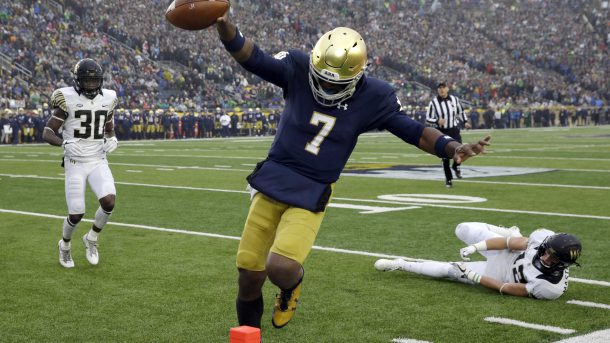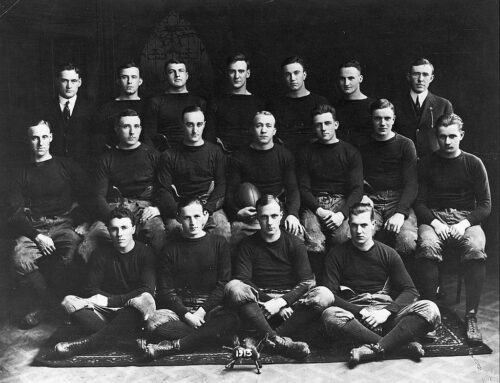This morning Irish Sports Daily broke the news that Ian Book will not play Saturday against Florida State. Brian Kelly will address the injury at his press conference today and likely provide additional details, but according to the ISD report Book “suffered multiple injuries to his midsection” in the Northwestern game, and a timetable for his return is unknown, but “there is some hope he’ll be ready for Syracuse”.
ESPN quickly confirmed the report, describing it as a “rib injury” and providing a slightly more optimistic tone, stating that “the source added that Book is expected to to be available for the No. 3 Fighting Irish’s game against No. 13 Syracuse on Nov. 17.” More details may emerge about the severity and timetable of the injury, but it also seems likely that Kelly and the staff will keep details close to the vest to force future opponents to prepare for an offense that could look very different depending on whether it’s Book or Wimbush behind center.
What is the impact for the Notre Dame offense?
It’s not good! The Irish offense went from averaging just over 5 yards per play with Wimbush through three games to nearly 7 with Ian Book leading the offense. Brandon Wimbush had just one game (at Michigan State in 2017) in his 15 career starts with a passing success rate of 50% or greater. Book has just one game under that efficiency level in his six starts in 2018 (at Virginia Tech). It’s a small sample size, and Wimbush’s sample is particularly weird since it includes the current #1 Defense in S&P+ and Ball State, but a quick glance shows the difference in the passing game’s efficiency and explosiveness.
(Note: YPSP is yards per successful play, and I’ve bucketed these as Wimbush games (Michigan, Ball State, and Vanderbilt) although these numbers still count the few snaps Book took

The offense appears a little bit more explosive with Wimbush, but 7 of the 12 gains of 20+ yards came from the Ball State game. The efficiency of the offense takes a major hit – in the first three games the offense converted 36.3% of third downs, compared to 49.3% in the next six. Florida State currently sits at 39th in Defensive S&P+, 3rd best on the schedule behind Michigan (1st) and Northwestern (32nd).
What might the offense look like versus FSU?
As I pointed out in the Northwestern advanced stats review, the run/pass splits with Book at QB have been essentially 50/50 (with sacks counted as passes, scrambles as runs). That ratio with Wimbush at QB was previously about 60% run versus 40% pass, and I’d anticipate that will continue. In his last start, against Vandy, Chip Long ran the ball on 26 of 33 first down plays. Despite the offense as a whole still struggling in that game, that approach worked well – those runs averaged 6.1 yards per carry and were successful (gains of 5+) on 50% of those carries (run success average is about 40%).
In both 2017 and early 2018 the Irish struggled on passing downs, and countered that with a high run rate in these situations. Again, looking at Vanderbilt as a bit of a blueprint, running often on those early downs allowed ND to have an average 3rd down distance to gain of 5.4 yards, their lowest of the season. The Noles are pretty balanced defensively (33rd in Rushing S&P+, 35th in Passing S&P+) and figure to load up against the run. For all of their struggles this season, FSU’s defensive line is a strength, and they’ve been pretty disruptive against the run, with a run stuff rate of 22.5% that ranks 26th nationally. That’s a concern for an offensive line that allowed a ton of run stuffs against Michigan and Ball State, but then stabilized against Vanderbilt, but notably struggled a bit at Northwestern last week (29% run stuff rate allowed).
Still, the biggest mismatch in this game remains the Irish defense, and specifically defensive line, against an FSU offense that’s been abysmal in 2018. I’d expect some calculated gambles but a generally conservative offensive approach, because it shouldn’t take a massive scoring effort to win this game. FEI (with no knowledge of Book’s injury) projects a score of 38-9, and S&P+ projects 36-13. Around 24 points is likely to get it done, barring turnovers (possible!), special teams miscues (very possible!), or a defensive collapse (very unlikely).
How can Chip Long make life easier for Wimbush?
Through the first few games of the season Brian Kelly made several comments about how the offense can better set up Wimbush for success, with a lot of references to recognizing what he can do and not asking him to do things that aren’t his strengths. I’d expect far fewer screens, RPO’s, and touch passes that Book has opened up in the playbook.
One easy opportunity, since the defense is likely to focus heavily on Wimbush’s threat as a runner, is to increase creativity in the run game. There’s been very little misdirection in the run game, with only occasional jet sweeps or utilization of a receiver coming across the formation as a fake. The USC last game shows his this threat can help -several early successful Kevin Stepherson runs to the perimeter helped set up easy opportunities later in the game. On a key 3rd down, after that motion had been utilized a couple times in the first half already, the threat of another WR run (this time with Claypool) distracts defenders, as does the threat of a handoff to Josh Adams, and Wimbush has an easy pitch and catch for a big gain.
(I’m not a doctor, but I’d also prescribe this highlights to anyone experience Wimbush-induced anxiety between now and Saturday evening).
Finally, I think the offense can help Wimbush by utilizing multiple personnel groupings, but spreading the Noles horizontally fairly often with multiple WR sets. The Noles will certainly put a lot of defenders around the line of scrimmage regardless, but a lot of NFL analytics to date support a fairly simple formula for run success. Much of run success is determined by the number of defenders in the box, and offenses can directly determine this number through personnel formations (see this article for substantial evidence of how the Rams have used this to great success – despite being one of league’s best backs, Gurley runs into heavy boxes far less often than others because of Sean McVay’s utilization of 3 WR personnel groupings).
So once again, if I was Chip Long I’d be spreading things out for the offense to give Wimbush, Dexter Williams, and Jafar Armstrong a bit more room to operate. At the very least, even if FSU still cheats against the run, this should make Wimbush’s reads easier and ensure he knows where one on one matchups are. FSU corner Levonta Taylor is out, and Notre Dame still features almost exclusively very large and very talented receivers. If FSU is selling out against the run the things that Wimbush was able to find some success with against Michigan – crossing routes to Claypool or other receivers underneath, and one on one throws like the one below to Miles Boykin – should be there for some low-risk, high-reward throws.





Timely analysis, I feel better!
Welp, get ready to see about 40 non-RPO zone reads from shotgun!
Well, this is not going to be very fun! A 42-10 game just turned into like a 24-17 IMO (more punts and pressure on the defense).
Definitely in the realm of possibility, but the defense may rise to the occasion. Could see this playing out a bit like Michigan-Michigan State…UM botched some scoring chances and only finished with about 5 YPP, but the defense clamped down and MSU could barely move the ball so it was a solid 21-7 win that could have been more.
That may be an overly optimistic view, but against this offense I think the defense can really clamp down. The Noles were just over 3 YPP against Miami and Clemson. I don’t think our defense will give up much more, at least before garbage time.
True, I mean this front 4 against THAT terrible offensive line is going to be really, really nasty. But in a good way. Hopefully now especially the defense can get a turnover or two and even maybe score themselves.
I think that really depends if FSU just quits in the cold weather. If we can get a 10 point lead, I think we’ll be able to coast.
The FSU people I talk to are very adamant that we could start you or me at QB and still win the game. might be closer, but it’s hard to overstate how god awful their offense is. Their 2nd QB did throw for 400 yards last week, and they still lost by 19. If Francois gets the start, he’s basically immobile, though, and one FSU friend was convinced we’d get double digit sacks. We’ll see, of course there is a lot of “woe is me” going on with FSU fans these days. But as long as we can generate points, we should be fine.
Why do you talk to Florida State people? Are you writing your dissertation on Jean shorts or something? That’s it isn’t it.
If there going to load up on the run, then we should just call a pass play but tell Wimbush to throw it only if he’s WIDE OPEN. Otherwise, just drop back and look for a hole to run – sort of like a delayed QB draw. His best play is a broken pass play for a long run.
Great analysis. I loved that 538 article when it came out and agree we should spread them out to run it. It also makes the matchups on the outside one on one and like against Michigan Wimbush may be able to hit Boykin for a deep one. Boykin has gotten really good at going up for the ball for the catch.
I joked in our Slack we need to run the old Madden ’04 Michael Vick offense….send everybody deep with a RB underneath, scramble, get the edge, run for a 1st down, and repeat.
It will all be fine when we run out of the tunnel in green jerseys
That’s…why would you say this? That’s so mean. Just…horrible. You’re a mean person.
I’m still holding out hope. Under Armour did just start selling these bad boys about a week or two ago….But then again I always hold out hope for the green jerseys and it never happens so who knows. May be just sneaking out a green design if the abominable Yankees/ND jerseys aren’t selling (which how could they be).
https://www.fanatics.com/_Number_7_Notre_Dame_Fighting_Irish_Under_Armour_Football_Replica_Jersey__Kelly_Green/t-34093244+o-61+d-42336723+f-47562951+z-9-1243938163?utm_medium=cse&cid=GOAL&_s=GPA_CA&sku=11457357&targetid=pla-301443523843&gclid=EAIaIQobChMIlMDcqPLF3gIVQgOGCh13CQMOEAQYASABEgJCFPD_BwE
Well, I’m sure you’re aware by now that your wish came true. They announced green jerseys last night with an amusing ‘Rudy’ homage.
Reports are it was the players’ idea, but the cynical view certainly is that UA is taking a bath on those stupid Shamrock jerseys and needed to goose the numbers.
Doesnt the whole running from spread sets thing only work if the defense follows along with personnel? If they pull a Miami and just ignore the pass I don’t think it helps to be running with no TEs does it?
This is definitely a possibility. I could see them just doing a run blitz with tight coverage on the receivers all game long. If it works for them 3 plays in a row, we punt. If not, chunk yardage for the good guys, and we start over.
Or alternatively, give us a bit of a padding on the short stuff since they won’t expect him to hit on those anyway, and take away the intermediate throws. Might make more sense because we’d have to hit on 2 of those to get a first down instead of one.